Business
Trump’s H-1B visa move: End of the road Indians’ American dream? How fee hike may help India retain talent – The Times of India

US President Donald Trump’s move to sharply hike the fee for H-1B visas to $100,000 has Indian tech sector workers and students in America worried about their future in the world’s largest economy. Trump’s move is aimed at addressing worries about US technology workers who believe they lose out on jobs due to immigrant professionals.The H-1B skilled-worker visa programme, which is mainly utilised by the technology sector, has traditionally served as a crucial entry route for foreign professionals into the United States, with Indian nationals comprising approximately 70% of recipients.Now these professionals and students face a significant impact as the Trump administration revises the programme.
Indians & H-1B visas
Indian parents have over the years consistently encouraged their offspring to pursue academic paths—specifically engineering—believing these would provide optimal employment prospects. The Indian Institutes of Technology have produced exceptional English-proficient computer specialists and engineers who became highly sought after in the United States, according to a Wall Street Journal report.Britta Glennon, an economist and assistant professor of management at the Wharton School specialising in immigration and innovation research, told WSJ that Indians demonstrated exceptional engagement with the H-1B programme following its establishment in 1990.The achievements of Indian technology professionals who received H-1B visas inspired more Indian students to pursue similar educational paths, according to Glennon. A notable example is Sundar Pichai, who now leads Alphabet. Indians comprised more than one-third of successful H-1B visa recipients by 2003.Also Read | The $100,000 H-1B gamble: Why Donald Trump’s visa tax won’t save American jobs – winners and losersIn 2007, when visa applications exceeded available positions, US authorities implemented a lottery-based allocation system.
Why are Americans complaining about H-1B visas?
According to the report, US employees have lodged multiple complaints with the Equal Employment Opportunity Commission against Tata Consultancy Services, India’s largest technology services organisation, claiming they were dismissed and their positions were filled by H-1B visa holders.Last year, TCS received 5,500 H-1B visas, placing it second to Amazon’s allocation of over 14,000. The yearly limit stands at 85,000 visas, with educational institutions being exempt from this restriction.TCS has previously stated that these allegations lack substance and emphasised its proven track record as an equal-opportunity employer within the United States.According to research by Colgate University economists Rishi R. Sharma and Chad Sparber quoted in the report, the change to lottery system led Indian outsourcing companies—which provide tech services to American businesses through combined US-based and India-based teams—to submit many applications to enhance their chances of securing H-1B visas.Subsequently, these Indian service providers began lending their surplus US-based Indian employees to clients, triggering protests from American workers who felt they were being displaced through domestic outsourcing.Experts note that whilst outsourcing companies must legally demonstrate payment above certain thresholds, the compensation offered to H-1B employees at these firms typically falls in the lower range for similar positions.

Companies dependent on H-1B visas
Indian outsourcing companies indicate they have reduced their dependence on H-1B visas whilst focusing on training and employing American workers.Also Read | Alternatives to H-1B visas: After fee hike by Trump to $100,000, O1 & L1 visas gain traction; check cost, approval rates
H-1B visa overhaul: Troubles for startups
US is implementing new changes to the H-1B visa programme. The new fee structure will be introduced for first-time applicants beginning next year, alongside plans to modify the lottery system to prioritise applications with higher salary offerings.The increased fees may be a deterrent for startups. Siddharth Sarasvati, at Trial and Error, an AI starup told WSJ that the increased fee poses challenges for startups like theirs. “H-1B needed reform,” said Sarasvati. “But this isn’t reform, it’s a sledgehammer…this ensures that only companies with the deepest pockets can play.”
H-1B visa fee hike: Will it end up being advantage India?
India could potentially gain advantages from stricter US visa regulations affecting Indian technology professionals. According to experts, India’s technological advancement partly resulted from professionals returning after unsuccessful H-1B applications, contributing to the development of centres like Bengaluru.Industry experts are debating the potential global impact of the proposed new visa fee on the IT workforce landscape. Vivek Wadhwa, who leads Vionix Biosciences and previously served as a distinguished fellow at Harvard Law School and Carnegie Mellon, highlighted serious implications for the United States.
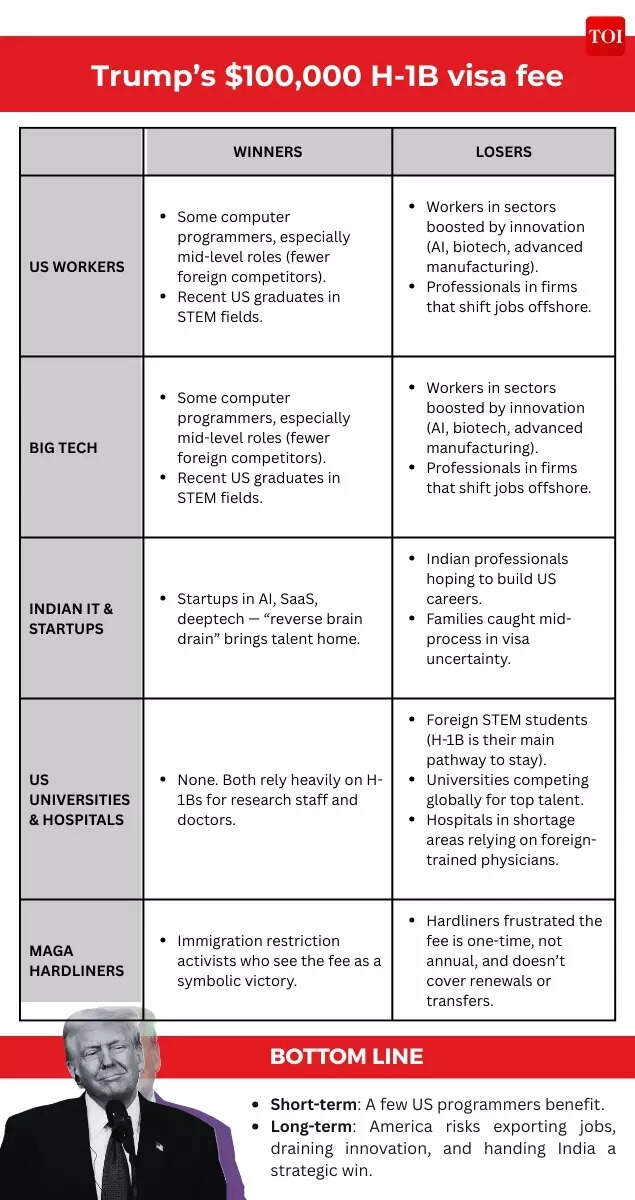
Trump’s H-1B visa fee hike: What it means
“Trump’s $100,000 H-1B fee is economic suicide for America. It will force Indian talent to go home, taking with them skills, savings, and global experience. Indian engineers have been trapped in limbo for years because of endless visa backlogs. Trump has just pushed them to make the obvious choice: return home where opportunities are greater,” he was quoted as saying by TOI. Wadhwa noted that this reverse migration would significantly advantage India. “They will bring capital, networks, and the knowhow of scaling companies globally.”“Donald Trump’s 100,000 H-1B fee will choke U.S. innovation, and turbocharge India’s,” said Amitabh Kant, the former head of an Indian government-policy think tank, in a post on X. “By slamming the door on global talent, America pushes the next wave of labs, patents, innovation and startups to Bangalore and Hyderabad, Pune and Gurgaon.”Also Read | Trump’s H-1B visa fee hike to backfire? Wall Street banks set to rely more on Indian GCCs; may deepen presence in IndiaDespite increased opportunities in India over recent years, the country faces challenges. Many technology graduates struggle to secure well-compensated positions amongst the large talent pool. The work environment remains considerably more hierarchical compared to the United States, according to technology professionals quoted in the report. Additionally, artificial intelligence developments could reduce entry-level positions.A 31-year-old software engineer based in Albany, N.Y., who arrived in the US in 2017 for doctoral studies, highlighted the disparity in professional opportunities. “India has a lot of good schools to train engineers but nothing much to engage them after graduation,” he remarked. He obtained his H-1B visa in 2022 during his company’s first application attempt.Despite finding the visa’s single-employer restriction limiting, he appreciates the American technology sector’s environment. He and his spouse, also an H-1B holder, are considering alternative skilled-worker visa pathways to stay in the US, particularly if H-1B regulations become stricter. They view Canada as an alternative destination rather than returning home, the WSJ report said.Destinations such as Germany, the United Kingdom and Canada are actively seeking to attract skilled professionals from India.As the United States tightens its immigration policies for skilled workers, nations including Germany, Canada and the UK have positioned themselves as welcoming alternatives for Indian technology experts, according to an ET report.
Business
US agrees deal to slash Swiss tariffs to 15% after golden charm offensive

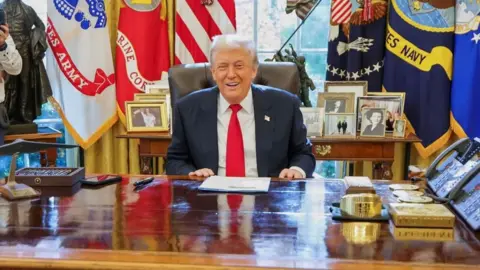 AP
APPaul KirbyEurope digital editor
Switzerland and the US have agreed to cut President Donald Trump’s steep 39% tariffs on Swiss exports to 15%, as part of a deal that involves a Swiss promise to invest $200bn (£150bn) in the US.
“It’s a great relief for our economy,” said Swiss Economics Minister Guy Parmelin, who said significant damage had been done since the additional tariffs had kicked in last August.
Parmelin said a move by Swiss business leaders to meet Trump in the White House last week had proved “decisive” in reaching a deal.
Industry chiefs visited the Oval Office, bearing gifts including a Rolex gold watch and a specially engraved gold bar from Swiss-based gold refining company MKS.
Initial attempts by Swiss President Karin Keller Sutter to change Trump’s mind had fallen on deaf ears. Trump said she “was a nice woman, but she did not want to listen”.
But after the 4 November encounter with Swiss business leaders, Trump revealed this week a deal was being worked on.
US Trade Representative Jamieson Greer confirmed an agreement had been reached, saying “President Trump’s unmatched dealmaking continues to deliver for the American people”.
The deal had involved very hard work, said chief trade negotiator Helene Budliger Artieda. Guy Parmelin said it would bring Switzerland into line with the 15% tariff rate negotiated with the US by its European Union neighbours.
The economics minister said it involved the Swiss economy investing $200bn directly in the US by 2028. A third of that Swiss money will be invested in the US in 2026 under the deal.
Switzerland has also agreed to axe tariffs on a quota of US meat exports including beef, bison and poultry.
Greer said the deal “tears down longstanding trade barriers” and Swiss investment would bring thousands of new jobs.
For Swiss industry, the deal could not come soon enough. Tech exports to the US are down 14.2% on the third quarter of last year, according to latest statistics – a dramatic fall since the tariff hike was imposed in August.
The role of Swiss industrialists appears to have been key, and some particularly those trading in luxury goods, gold, or commodities, already had contacts in Trump’s circle.
In September, Trump appeared at the US Open tennis final in the Rolex VIP box hosted by the Swiss watch company’s chief executive Jean Frédéric Dufour.
 MANDEL NGAN/AFP
MANDEL NGAN/AFPThe president even asked if the Rolex CEO would have been there if Trump had not slapped such steep tariffs on Switzerland.
Last week Dufour met Trump again, this time in the Oval Office, along with fellow business leaders including Johann Rupert from luxury goods maker Richemont and Marwan Shakarchi from MKS.
Days after the meeting, Trump was pictured in the Oval Office with what looked very much like a Rolex “Datejust” desk clock, produced by the company as a collector’s item, and worth tens of thousands of dollars.
A White House official has confirmed to the BBC the two items were given to Trump.
It is quite normal nowadays for visitors to the Oval Office to come bearing a gift.
UK Prime Minister Sir Keir Starmer brought an invitation from King Charles for a lavish state visit. German Chancellor Friedrich Merz offered a framed copy of the birth certificate of Trump’s German grandfather.
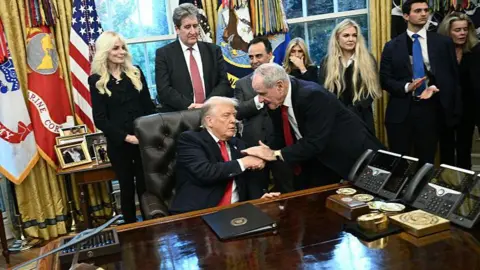 BRENDAN SMIALOWSKI/AFP
BRENDAN SMIALOWSKI/AFPThe US president receives thousands of gifts every year and they then become US property, deposited with the National Archives and filed annually by the state department.
They are eventually transferred to a presidential library. Some gifts can be kept but presidents have to pay federal taxes if they do not come from a close relative.
Swiss industry has been waiting for a deal with bated breath and a number of Swiss companies had warned they would have to furlough staff if nothing changed.
Yves Bugmann, who heads the Swiss Watch Industry Federation, welcomed the deal after months of uncertainty.
Asked what kind of investment the Swiss government might make in the US that would add up to $200bn, Helene Budliger Artieda said there was a detailed list that included pharmaceuticals, but she singled out plans for plane manufacturer Pilatus to build a big US plant and train-maker Stadler to expand its US operations in Utah.
Gold refining is also part of the plan.
“Currently, Switzerland is the primary location for gold storage, and New York is the primary location for trading,” said trade negotiator.
The chief trade negotiator said it would take a few days or even weeks for the changes to come into effect.
The agreement will only become binding when it receives approval from the Swiss parliament, and then it will be put to a referendum.
Business
Stocks hit and bond yields jump amid tax U-turn talk

Stocks fell and bond yields spiked in volatile trading on Friday amid uncertainty over UK Budget proposals after an apparent U-turn on tax policy by Chancellor Rachel Reeves.
The FTSE 100 Index closed down 109.31 points, 1.1%, at 9,698.37. It had earlier traded as low as 9,610.45.
The FTSE 250 ended 175.95 points lower, 0.8%, at 21,819.56, and the AIM All-Share slid 8.95 points, 1.2%, at 746.51.
For the week, the FTSE 100 was up 0.2%, as was the FTSE 250, while the AIM All-Share fell 0.7%.
Market volatility came after the Financial Times reported Ms Reeves had ditched plans to raise income tax to help fill an expected fiscal deficit.
The Treasury signalled the change came because of more positive fiscal forecasts from the Office for Budget Responsibility, although Ms Reeves has also faced a concerted pushback from Labour MPs opposing the move.
“The Chancellor will deliver a fair Budget,” the Prime Minister’s spokesman told political reporters at the daily lobby briefing.
“The Chancellor has been very clear on the need to deliver stability in the public finances. She wants to give companies the confidence to invest,” the spokesman added.
But the spokesman refused to be drawn on “speculation” on the reported decision not to raise income tax.
Kallum Pickering, at Peel Hunt, said if Ms Reeves stays clear of raising income tax rates or lowering the thresholds at which they are paid, her remaining option would be likely to be to opt for a haphazard patchwork of smaller anti-growth tax increases.
“That would be a bad outcome. It would add to uncertainty, further damage the Government’s already tarnished credibility, and complicate any (Bank of England) judgment to potentially offset tax rises with rate cuts,” he said.
More positively, Goldman Sachs said if reports prove correct, it probably suggests that the fiscal deterioration is slightly less severe than initially assumed.
The broker now pencils in a total fiscal consolidation of £25 billion in the Budget later this month versus £30 billion previously, requiring gross tax increases of £30 billion versus £35 billion previously.
The uncertainty sparked an upward move in bond yields, which move inversely to prices.
The yield on the UK 10-year gilt rose to 4.57% from 4.44% on Thursday, while the 30-year yield jumped to 5.39% from 5.23%. Both have fallen sharply in recent weeks as hopes rise of lower interest rates.
Sterling was quoted at 1.3158 dollars at the time of the London equities close on Friday, lower compared with 1.3197 dollars on Thursday.
The euro stood at 1.1617 dollars, lower against 1.1644 dollars. Against the yen, the dollar was trading higher at 154.58 yen, compared with 154.31 yen.
In European equities on Friday, the CAC 40 in Paris closed down 0.8%, while the DAX 40 in Frankfurt fell 0.7%.
In New York, the Dow Jones Industrial Average was down 0.3% at around the time of the London close. The S&P 500 index was 0.4% higher, while the Nasdaq Composite rallied 0.6%.
All three major US indices fell heavily on Thursday amid tech weakness and growing doubts that the Federal Reserve will cut interest rates in December.
The yield on the US 10-year Treasury was at 4.13%, stretched from 4.11% on Thursday. The yield on the US 30-year Treasury was quoted at 4.73%, widened from 4.69%.
Federal Reserve Bank of Minneapolis president Neel Kashkari said he did not support the US central bank’s last interest rate cut, though he is still undecided on the best course of action for its December policy meeting.
“The anecdotal evidence and the data we got just implied to me underlying resilience in economic activity, more than I had expected,” Mr Kashkari said in an interview with Bloomberg News. That, he said, argued for a pause to rate cuts at the Fed’s October meeting.
Back in London, a handful of stocks were in the green on the FTSE 100, with DCC, up 1.7%, leading the way.
Gold miners Endeavour Mining and Fresnillo were prominent fallers, down 2.9% and 1.7% respectively, as the gold price fell.
Gold traded sharply lower at 4,101.80 dollars an ounce on Friday against 4,206.40 dollars on Thursday.
Bookmaker Entain slumped 3.7%, with a hike in gambling taxes thought to be high on the list of likely Budget rises. William Hill owner Evoke fell 4.3%.
Banks weakened on fears the Budget uncertainty will knock economic growth, with Barclays off 3.2%, Lloyds down 2.8% and NatWest down 3.6%.
Land Securities fell 5.3%, with market uncertainty taking the shine off first-half results.
The London-based commercial property development and investment company said it continued to see “clear positive momentum across every part of our business” as it raised its interim dividend to 19p per share, up 2.2% from 18.6p a year ago.
In addition, Land Securities raised its like-for-like net rental income guidance for its current financial year ending March 31 to between 4% and 5%, up from its previous guidance between 3% and 4%.
Melrose Industries closed down 1.2% despite a positive trading update.
The Birmingham-based aerospace manufacturing company said group revenue grew by 14% in the four months to October 31, with Engines up 28%, driven by a strong performance in both original equipment and the aftermarket, and Structures up 5%.
Adjusted operating profit was significantly higher than the comparative period and in line with expectations, the firm said.
Brent oil was quoted higher at 64.57 dollars a barrel at the time of the London equities close on Friday, from 63.14 dollars late on Thursday.
The biggest risers on the FTSE 100 were DCC up 82 pence at 5,020p, WPP, up 1.8p at 288.3p, Burberry Group, up 4p at 1,232p, AstraZeneca, up 38p at 13,532p and Rentokil Initial, up 1.1p at 403.6p.
The biggest fallers on the FTSE 100 were Land Securities, down 34p at 613p, Kingfisher, down 12.4p at 295.6p, Entain, down 27p at 700.4p, NatWest, down 22.4p at 600.8p and Barclays, down 13.75p at 413.5p.
Monday’s global economic calendar has Canadian CPI data, Japan GDP and industrial production figures, and the New York empire state manufacturing index.
Monday’s UK corporate calendar has half-year results from storage company Big Yellow Group.
Later in the week results are due from tobacco company Imperial Brands along with a third-quarter trading update from sports clothing and footwear retailer JD Sports Fashion.
Contributed by Alliance News
Business
Price rises set to cool in reprieve for households after September peak

Price rises could be cooling off across the UK after inflation peaked in September, offering some relief to households, experts believe.
Economists think the rate of Consumer Prices Index (CPI) inflation will have fallen in October, when official statistics are published on Wednesday.
It comes after the Bank of England said last week that it thinks inflation has “peaked” and will begin to come down.
CPI came in at 3.8% in September, remaining at the same level as both July and August, the latest data from the Office for National Statistics (ONS) showed.
Some economists are expecting CPI to fall to 3.5% in October.
Elevated food and drink inflation has helped put pressure on the overall rate this year, with households seeing steep rises particularly for items such as chocolate, coffee, cheese and eggs.
However, the cost of food and non-alcoholic drinks fell between August and September, the first monthly decline since May last year.
Experts think food price inflation could continue to ease in October.
Furthermore, energy costs are expected to be an important factor putting downward pressure on the overall inflation rate.
Ofgem raised the energy price cap by 2% in October, but this is significantly less than the 9.6% hike last year, meaning energy price inflation is set to fall.
Jack Meaning, chief UK economist for Barclays, said he thinks September “represented the peak of the inflation hump” and that CPI will fall to 3.5% in October.
Robert Wood and Elliott Jordan-Doak, UK economists for Pantheon Macroeconomics, also said they were forecasting inflation to ease to 3.5%, driven by energy costs.
But they also cautioned over a hike in university tuition fees, particularly for international students, putting upward pressure on inflation last month.
Sanjay Raja, chief UK economist for Deutsche Bank, predicts a smaller fall in overall inflation to 3.7% in October.
But he said that the upcoming autumn Budget was likely to mark the “next most important inflation forecast update”, with the potential for tax rises pushing down on inflation.
“Speculation around lower energy bills, indexation costs, duties and food prices remain rife,” Mr Raja wrote in a research note.
“We expect the Chancellor to push through some modest measures to pull down on prices come November 26.
“This will give us a good sense of where 2026 inflation will land.”
-

 Entertainment7 days ago
Entertainment7 days agoChina unveils£5.4 bn Fujian, its most advanced aircraft carrier yet
-

 Politics7 days ago
Politics7 days agoIDF lawyers warned of possible Gaza war crimes: US intel findings
-

 Entertainment7 days ago
Entertainment7 days agoRobert Pattinson jokes about competing with Gen Z
-

 Entertainment1 week ago
Entertainment1 week agoMeghan Markle returns to acting in star-studded film: details inside
-

 Tech1 week ago
Tech1 week ago‘Vibe coding’ named word of the year by Collins dictionary
-

 Business1 week ago
Business1 week agoFM asks banks to ensure staff speak local language – The Times of India
-
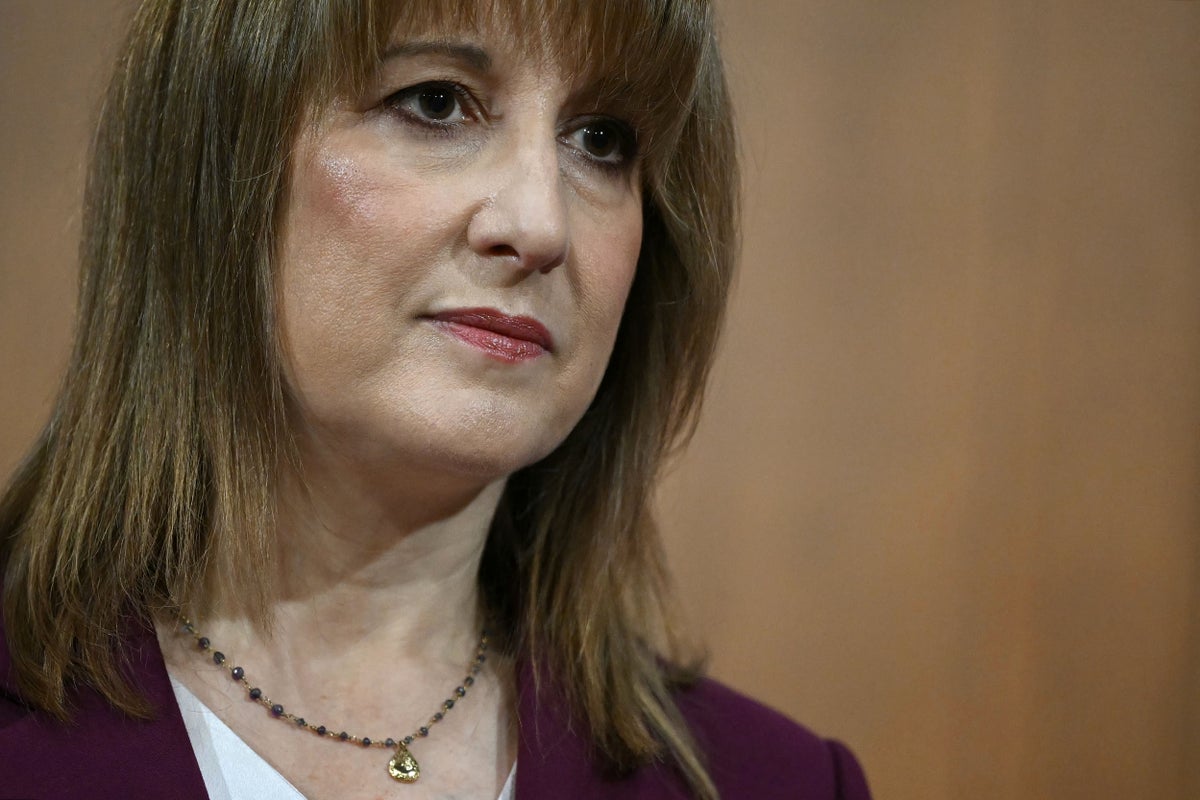
 Business1 week ago
Business1 week agoBudget tax hikes could see food prices soar, major supermarket boss warns
-
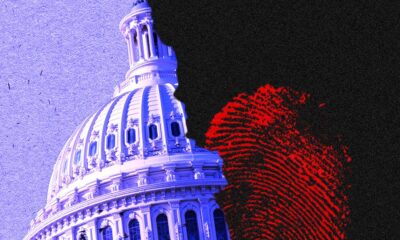
 Tech1 week ago
Tech1 week agoThe Government Shutdown Is a Ticking Cybersecurity Time Bomb
















